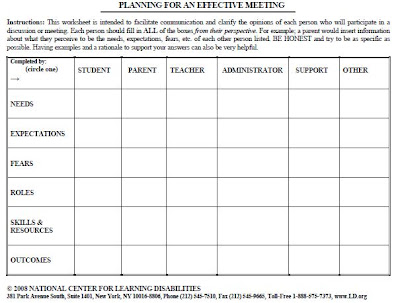Whether a parent or a teacher, chances are that you have been called in for a meeting or two.
People often view meetings as an indicator that something is changing or that there is a problem that needs to be addressed. This can result in the perception that something is "wrong" causing people to walk in to a meeting feeling anxious. Couple this with an intimidating list of people attending such as administrators and specialists, it's easy to walk into a meeting defensive or even hostile.
Obviously, this can interfere with the productivity of the meeting, and cause for parent/teacher, teacher/teacher, or teacher/administrator relationships to begin to break down.
Finding out the specific purpose of the meeting can help to alleviate anxiety and allow everyone to be appropriately prepared, but I came across a great tool recently that helps to make sure that everyone present at a meeting enters the meeting prepared and on the same page.
The tool is a chart that identifies information that can be gathered prior to the meeting by everyone attending. It serves to get everyone on the same page and highlights discrepencies which can then be addressed. The chart leaves room to jot down notes on the following issues: - Concerns
- Outcomes
- Roles
- Needs
- Expectations
- Resources
- Skills
I remember the points I need to gather information on with this with the acronym CORNERS. This works well because by understanding another's ideas about what concerns them most, what they hope the outcome of the meeting will be, what they percieve their role to be, etc., essentially puts you in their corner. Of course, it is also important that you explore and communicate your own CORNERS so that you can address areas causing you concern.
Ways to Use the Meeting Chart Tool
This information can be shared a number of formal and informal ways prior to meeting. To be most effective, LD.org recommends that each person writes their own views for each CORNERS issue, but then also fills out what they percieve as being other's CORNERS. Don't forget to have the student also fill out a meeting chart of their own so that they can have their voice heard even if they are not present for the actual meeting.
Another use of the chart would be to have each person attending fill out the chart in the designated column, and pass it along to the next person who does the same. The finished chart will have each person relating their own needs and expectations and if a finished copy is supplied to each person then everyone will go into the meeting knowing what each wants to get from the meeting and what their frame of mind is. It is important that all attendees are comfortable with this process, as some people will feel more comfortable knowing their sheet is being returned only to the classroom teacher or administrator rather than all attendees.
If such a formal written account of CORNERS is not necessary, the information can be gathered informally with a quick phone call, email, or face-to-face encounter at pick-up or drop-off times. Teachers can ask parents what their greatest concern is with regards to the meeting, what they hope the outcome of the meeting will be, and what they need from you to realize that goal. Parents will likely appreciate having their feelings and concerns heard and will help to put them at ease. Parents, too, can ask teachers very similar questions allowing them to gain important information and perspective.
If you don't choose to distribute the chart to everyone prior to the meeting, bring a copy into the meeting anyway. This chart can be brought to the meeting and filled in as the meeting progresses. If the meeting stalls or if it begins to go in an unproductive direction, refer to your chart. Gapping holes in the chart may prompt you to ask certain questions that will help the meeting get back on track and help everyone feel heard.
A copy of a Meeting Chart is available through this link: MeetingChart.pdf
The chart begins by asking about needs first. This is a good place to start because it shifts thinking away from being defensive or being on the attack, to thinking about what their needs are and how they can be met. It sets the focus as the rest of the chart is filled out, and hopefully sets the tone of the meeting that will follow.
I have altered the chart to suit my own needs, and it is pictured below. If you would prefer copies of this alternate Meeting Chart, post a request at the end of post or contact me directly (see the About Me section) and I would be happy to send you a copy via email as an attachment. If you are a a Techie and you know how I would go about uploading the pdf version to this website please let me know! I have a pdf version saved, but I don't know how to upload it as link for visitors to download.
Here is a different version of the Meeting Chart that I use for smaller meetings with just the student, or the parents.



